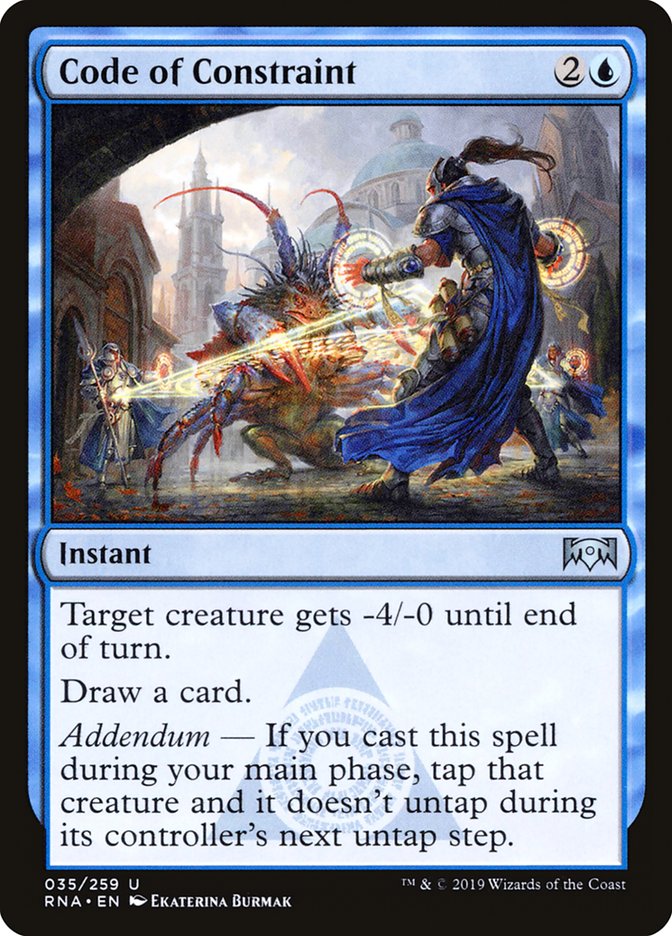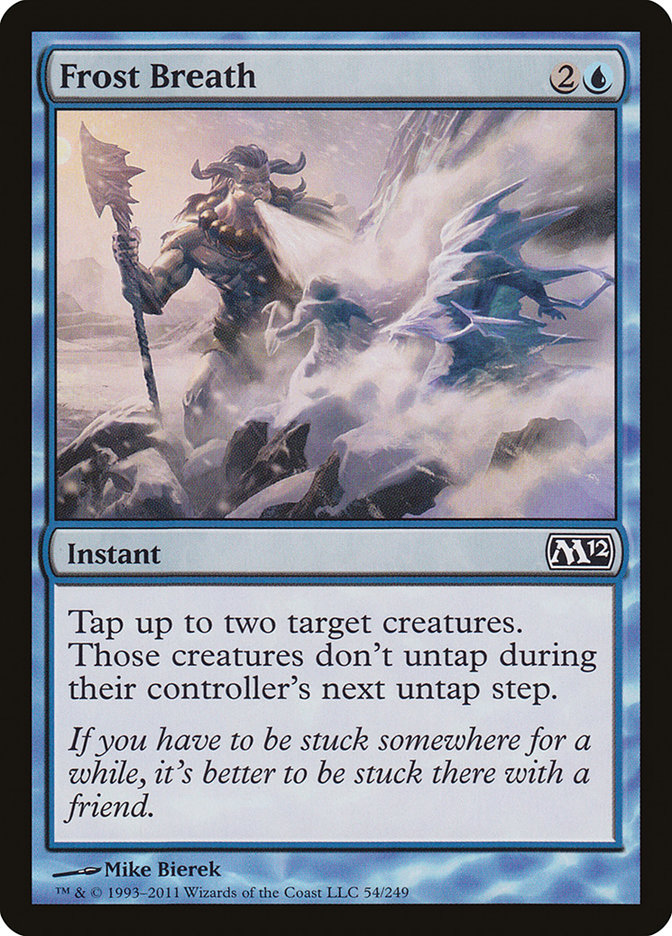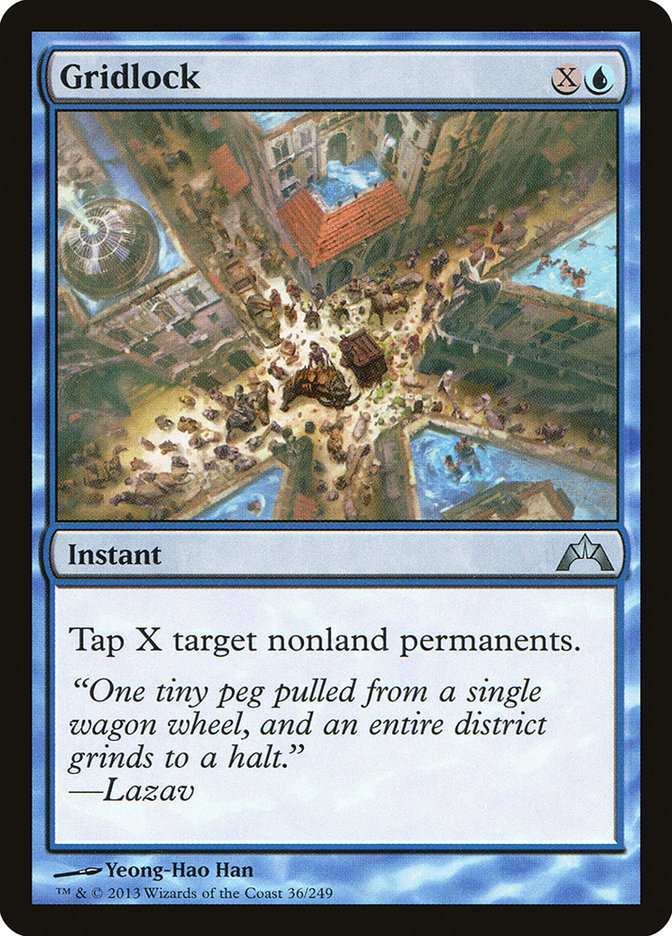Código de represión Carta MTG
| Colecciones da carta | Lanzado en 2 coleccionesVer todos |
| El coste de maná | |
| Costo de maná convertido | 3 |
| Rareza | Poco común |
| Tipo | Instantáneo |
| Habilidades | Addendum |
Texto de la carta
La criatura objetivo obtiene -4/-0 hasta el final del turno. Roba una carta. Adenda — Si lanzas este hechizo durante tu fase principal, gira esa criatura y no se endereza durante el próximo paso de enderezar de su controlador.
Cartas Similares
El Código de Restricción se destaca en el ámbito de los hechizos de control en MTG. Encuentra sus paralelos en cartas como Aliento Helado, que puede inmovilizar a varias criaturas, impidiendo que se despierten durante el próximo paso de desbloqueo. Sin embargo, la versatilidad del Código de Restricción se hace evidente con la ventaja adicional de robar cartas si se lanza durante tu fase principal. A diferencia de Aliento Helado, que es puramente reactivo, el Código de Restricción también puede contribuir proactivamente a tu mano mientras obstaculiza el tablero de un oponente.
Otra carta que refleja la esencia del Código de Restricción es Estancamiento. Mientras que Estancamiento te permite atascar varios permanentes que no sean tierras, carece del beneficio de robar cartas que hace que el Código de Restricción sea una opción atractiva para los mazos que buscan mantener la ventaja de cartas. Además, el Código de Restricción interactúa con el mecanismo de Adenda, ofreciendo un incentivo integrado para la sincronización estratégica que Estancamiento no proporciona.
Comprensiblemente, al explorar opciones para el control y la ventaja de cartas, el Código de Restricción ofrece una combinación que podría atraer a los jugadores que valoran la flexibilidad en sus hechizos de control, convirtiéndolo en una inclusión notable en las estrategias de MTG centradas en el tempo y la inventiva.
Aspectos Positivos de la Carta
Ventaja de Cartas: Code of Constraint es experto en agregar cartas a tu mano mientras simultáneamente obstaculiza a tu oponente. Cuando se juega, la carta no solo tumba una criatura objetivo, lo que puede obstaculizar los ataques entrantes o los bloqueadores clave, sino que también tiene la codiciada habilidad de Addendum. Si se lanza durante tu fase principal, robas una carta, aumentando así tus recursos y manteniendo la presión en el tablero.
Aceleración de Recursos: Aunque no proporciona aceleración de mana directamente como algunos otros hechizos, Code of Constraint puede ser una jugada crucial que ralentiza el desarrollo del tablero de tu oponente. Al paralizar posibles amenazas o posibles bloqueadores, obtienes el beneficio indirecto de poder comprometerte más en el tablero tú mismo, acelerando esencialmente tu plan de juego en comparación con el de ellos.
Velocidad Instantánea: La naturaleza de velocidad instantánea de Code of Constraint sirve para dos propósitos en un juego. Te permite reaccionar con precisión a las jugadas de tu oponente durante su turno, interrumpiendo potencialmente sus estrategias en un momento crítico. Combinado con el beneficio de Addendum, fomenta la planificación estratégica, permitiéndote elegir si usarlo como una herramienta de interrupción rápida o esperar el momento óptimo para obtener la máxima ventaja de cartas.
Aspectos Negativos de la Carta
Requisito de Descarte: La carta Code of Constraint de MTG exige que un jugador descarte una carta para activar su máximo potencial. Esto puede ser un arma de doble filo, especialmente si tu mano ya está vacía, haciendo que el coste a veces sea demasiado alto en situaciones donde la ventaja de cartas es crucial.
Coste de Mana Específico: Con mana azul y blanco en su coste de lanzamiento, Code of Constraint a menudo puede ser restrictivo. No es cualquier mana el que bastará, lo que significa que esta carta es principalmente viable en mazos Azorius u otros que puedan producir ambos tipos de mana de manera confiable.
Coste de Mana Comparativamente Alto: Con un coste de lanzamiento que se sitúa más alto en la curva, es posible argumentar que Code of Constraint puede no ser la elección más eficiente en cuanto a herramientas de control. En un juego donde el tempo y la gestión de recursos son clave, los jugadores podrían encontrar que otras cartas de menor coste son más versátiles o tienen un impacto más rápido en el estado del juego.
Razones para Incluir Code of Constraint en tu Colección
Versatilidad: Code of Constraint ofrece opciones estratégicas en varios mazos basados en azul debido a su capacidad para obstaculizar a los oponentes al tapar sus criaturas y potencialmente robar una carta. Esto lo hace útil para jugadas de tempo y para mantener el control del tablero.
Potencial de Combo: En mazos que giran en torno a lanzar múltiples hechizos en un solo turno o se centran en interacciones a velocidad instantánea, Code of Constraint puede ser una pieza clave, especialmente porque se puede lanzar durante el turno de un oponente, encajando perfectamente con planes de juego reactivos.
Relevancia en el Meta: Dada su capacidad disruptiva, Code of Constraint demuestra su valía en metas dominadas por mazos agresivos centrados en criaturas. Ralentizar el impulso de tu oponente mientras rellenas tu mano puede ser crucial para mantener la delantera en el juego.
Cómo Vencer a Code of Constraint
Superar a Code of Constraint requiere juego estratégico y un mazo cuidadosamente seleccionado. En el contexto de Magic: The Gathering, es comparable a cartas como Unsubstantiate o Disperse, que pueden ayudar a los jugadores a lidiar temporalmente con amenazas devolviéndolas a la mano de su propietario. No obstante, Code of Constraint tiene la ventaja adicional de robar una carta, junto con su habilidad de Addendum, que tumba la criatura objetivo si se lanza durante tu fase principal. Para contrarrestar esto, considera utilizar hechizos a velocidad instantánea que se puedan jugar en respuesta a Code of Constraint. Cartas que otorgan a tus criaturas indetectabilidad, como Blossoming Defense, pueden anular efectivamente sus efectos, asegurando que tus criaturas sigan siendo una amenaza en el tablero.
Además, un mazo con una estrategia sólida de contrahechizos puede ayudar también. Manteniendo mana abierto, puedes frustrar el intento de tu oponente de lanzar Code of Constraint, manteniendo la ventaja en el tablero. Cartas como Negar o Veto de Dovin son particularmente efectivas, ya que están diseñadas para contrarrestar específicamente hechizos que no son criaturas. Recuerda, ser proactivo y predecir los movimientos de tu oponente te otorga la ventaja y te posiciona para vencer con éxito los efectos restrictivos de Code of Constraint.
Donde comprar
Si estás buscando comprar una carta MTG Código de represión de un coleccione específico como Ravnica Allegiance and Ravnica: Clue Edition, existen varias opciones confiables que debes considerar. Una de las fuentes principales es tu tienda de juegos local, donde a menudo puedes encontrar paquetes de refuerzo, cartas individuales y mazos preconstruidos de colecciones actuales y pasadas. A menudo ofrecen el beneficio adicional de una comunidad donde puedes intercambiar con otros jugadores.
Para un inventario más amplio, particularmente de colecciones más antiguos, mercados en línea como TCGPlayer, Card Kingdom y Card Market ofrecen amplias selecciones y te permiten buscar cartas de colecciones específicos. Las plataformas de comercio electrónico más grandes como eBay y Amazon también tienen listados de varios vendedores, lo que puede ser un buen lugar para buscar productos sellados y hallazgos raros.
Además, el sitio oficial de Magic suele tener un localizador de tiendas y listas de minoristas para encontrar Wizards of the Productos con licencia costera. Recuerde comprobar la autenticidad y el estado de las cartas al comprarlas, especialmente a vendedores individuales en mercados más grandes.
A continuación se muestra una lista de algunos sitios web de tiendas donde puede comprar las Código de represión y otras cartas MTG:
 COMPRAR
COMPRAR BurnMana es un socio oficial de TCGPlayer
- eBay
- Card Kingdom
- Card Market
- Star City Games
- CoolStuffInc
- MTG Mint Card
- Hareruya
- Troll and Toad
- ABU Games
- Card Hoarder Magic Online
- MTGO Traders Magic Online
Ver productos MTG
Impresiones
La carta Código de represión Magic the Gathering se lanzó en 2 colecciones diferentes entre 2019-01-25 y 2024-02-23. Ilustrado por Ekaterina Burmak.
| # | Liberado | Nombre | Código | Símbolo | Número | Marco | Disposición | Borde | Artista |
|---|---|---|---|---|---|---|---|---|---|
| 1 | 2019-01-25 | Ravnica Allegiance | RNA | 35 | 2015 | Normal | Negra | Ekaterina Burmak | |
| 2 | 2024-02-23 | Ravnica: Clue Edition | CLU | 83 | 2015 | Normal | Negra | Ekaterina Burmak |
Legalidades
Formatos de Magic the Gathering donde Código de represión tiene restricciones
| Formato | Legalidad |
|---|---|
| Historicbrawl | Legal |
| Commander | Legal |
| Historic | Legal |
| Legacy | Legal |
| Modern | Legal |
| Oathbreaker | Legal |
| Vintage | Legal |
| Duel | Legal |
| Explorer | Legal |
| Gladiator | Legal |
| Pioneer | Legal |
| Timeless | Legal |
Reglas e información
La guía de referencia para las reglas de las cartas Código de represión de Magic: The Gathering proporciona las reglas oficiales, las erratas emitidas, así como un registro de todas las modificaciones funcionales que se han producido.
| Fecha | Texto |
|---|---|
| 25/01/2019 | Las habilidades adicionales de los hechizos instantáneos se aplican mientras el hechizo se está resolviendo, no inmediatamente después de lanzarlo. Si el hechizo es contrarrestado, no obtienes el bono adicional. Por ejemplo, si lanzas la Visión de la Esfinge durante tu fase principal, ganas 2 vidas durante su resolución, después de robar dos cartas. |
| 25/01/2019 | El Código de Restricción puede apuntar a una criatura que ya está girada. Si lo lanzas durante tu fase principal, esa criatura no se enderezará durante el próximo paso de enderezar de su controlador. |
| 25/01/2019 | Si se copia un hechizo con una habilidad de añadido, la copia no te otorgará el bono de añadido. Esto se debe a que la copia no fue lanzada en absoluto. |
| 25/01/2019 | Si la criatura objetivo es un objetivo ilegal en el momento en que Código de Restricción intenta resolverse, el hechizo no se resuelve. No robas una carta. |



